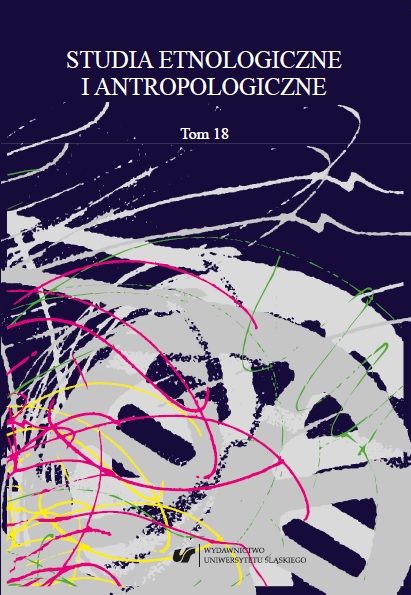Andrijanić B.: Wytatuowany znak wiary. „Gość Niedzielny” 2012, nr 14. https://www.gosc.pl/doc/1121865.Wytatuowany-znak-wiary [data dostępu: 12.03.2012].
Google Scholar
Benedict R.: Wzory kultury. Przeł. J. Prokopiuk. Warszawa 2005.
Google Scholar
Bilski R.: Wstęp. W: Bałkany 15 lat po wojnie. Red. M. Skóra, Z. Skupień, M. Sowiński. Kraków 2011, s. 5–6.
Google Scholar
Braun-Falco O. et al.: Dermatologia. T. 2. [Przeł. A. Czaplewski et al.]. Lublin 2004.
Google Scholar
Breczko S.: Ciało w socjologii – między indywidualizacją a polityzacją. „Kultura Współczesna.
Google Scholar
Teoria, Interpretacje, Praktyka” 2009, nr 1 (59): Kultura ucieleśniona, s. 19–28.
Google Scholar
Budzyńska N.: Niezmywalny znak wiary. „Przewodnik Katolicki” 2011, nr 4. https://www.przewodnik-katolicki.pl/Archiwum/2011/Przewodnik-Katolicki-4-2011/Kultura/Niezmywalnyznak-wiary [data dostępu: 12.12.2013].
Google Scholar
Capus P.: Tatouages en Bosnie-Hercégovine. „Bulletins de la Société d’anthropologie de Paris” 1849, t. 5, serie 4, s. 625–632.
Google Scholar
Cynarski W.J.: Spotkania, konflikty, dialogi – analiza wybranych obszarów kultury fizycznej i turystyki kulturowej. Rzeszów 2010, s. 16.
Google Scholar
Delio M.: Tatoo. The Exotic Art of Skin Decoration. London 1995. Encyklopedia powszechna PWN. Warszawa 1996.
Google Scholar
Giddens A.: Socjologia. Przeł. A. Szulżycka. Warszawa 2008.
Google Scholar
Glück L.: Die Tätowierung der Haut bei den Katholiken Bosniens und Herzegowina. W: Wissenschaftliche Mitteilungen aus Bosnien und Herzegowina. Bd 2. Wien 1884, s. 400–461.
Google Scholar
Gopal J.: Podszepty Gabriela. Islam. Bilans krytyczno-historyczny. Przeł. M. Wysocki. Freiburg–Wrocław 2006 (za: http://religiapokoju.blox.pl/2011/05/islam-i-niewonictwo-seksualne-kobiet [data dostępu: 12.03.2012]).
Google Scholar
Jelski A.: Tatuaż. Warszawa 1993.
Google Scholar
Klaić B.: Rječnik stranih riječi (tudjice i posudjenice). Zagreb 1985.
Google Scholar
Kłoskowska A.: Kultura masowa. Krytyka i obrona. Warszawa 1964.
Google Scholar
Kosiewicz J.: Filozoficzne aspekty kultury fizycznej i sportu. Warszawa 2004.
Google Scholar
Krawczyk Z., Dziubiński Z.: Socjologia kultury fizycznej. Warszawa 1995.
Google Scholar
Lipoński W.: Mocowanie duszy z ciałem. O humanistyczny wymiar sportu. W: Kultura fizyczna w społeczeństwie nowoczesnym. Red. Z. Dziubiński, K.W. Jankowski. Warszawa 2009, s. 221–237
Google Scholar
Lombroso C.: Tatuaż przestępcy. Fragment dzieła Człowiek zbrodniarz w stosunku do antropologii, jurysprudencji i dyscypliny więziennej. Przeł. J.L. Popławski. Gdańsk 2014.
Google Scholar
Marjanić S.: Tetovirana duša. „Frakcija. Magazin za izvedbene umjetnosti” 1997, br. 4, s. 70–74.
Google Scholar
Mužić I.: Hrvatska povijest devetog stoljeća. Split 2007.
Google Scholar
Nowocień J.: Studium o pedagogice kultury fizycznej – Study on Pedagogy of Physical Culture. Warszawa 2013.
Google Scholar
Pawłucki A.: Nauki o kulturze fizyczne. Wrocław 2013.
Google Scholar
Pawłucki A.: Pedagogika wartości ciała. Gdańsk 1996.
Google Scholar
Pawłucki A.: Rozważania o wychowaniu. Gdańsk 1994.
Google Scholar
Petrić M.: O pitanju porijekla običaja tatuiranja kod balkanskih naroda. „Glasnik etnografskog muzeja u Beogradu” 1967, vol. 39–40, s. 219–237.
Google Scholar
Petrić M.: Običaj tatuiranja kod balkanskih naroda. Sarajevo 1973.
Google Scholar
Pismo Święte Starego i Nowego Testamentu. T. 1. Oprac. zespół. Red. M. Peter, M. Wolniewicz. Poznań 1974.
Google Scholar
Pośpiech J.: Wychowanie fizyczne i sport szkolny w krajach europejskich – wybrane problemy. Opole 2003.
Google Scholar
Słownik wyrazów obcych. Red. W. Kopaliński. Warszawa 1980.
Google Scholar
Snopek M.: Tatuaż. Element współczesnej kultury. Toruń 2010.
Google Scholar
Sztompka P.: Socjologia. Analiza społeczeństwa. Warszawa 2003.
Google Scholar
Truhelka Ć.: Tetoviranje katolika u Bosni i Hercegovini. „Glasnik Zemaljskog muzeja” 1984, br. 6.
Google Scholar
Wieczorkiewicz A.: Kultura ucieleśniona. Wprowadzenie. „Kultura Współczesna. Teoria, Interpretacje, Praktyka” 2009, nr 1 (59): Kultura ucieleśniona, s. 5–7.
Google Scholar
Zekić M.: Muzułmanie Bośniaccy – najbardziej zachodni autochtoniczni muzułmanie czy najbardziej wschodni muzułmańscy Europejczycy. W: Widziane, czytane, oglądane – oblicza obcego.
Google Scholar
Inny i obcy w kulturze. Cz. 1. Red. P. Cieliczko, P. Kuczyński. Warszawa 2008, s. 64–75.
Google Scholar
Zwoliński A. ks.: Mowa ciała. Gesty, stroje, tatuaże, makijaż… Kraków 2006.
Google Scholar


 https://doi.org/10.31261/SEIA.2018.18.14
https://doi.org/10.31261/SEIA.2018.18.14

 10.31261/SEIA
10.31261/SEIA